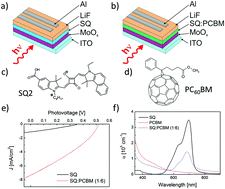当前位置:
X-MOL 学术
›
J. Mater. Chem. C
›
论文详情
Our official English website, www.x-mol.net, welcomes your
feedback! (Note: you will need to create a separate account there.)
Unravelling the role of electron–hole pair spin in exciton dissociation in squaraine-based organic solar cells by magneto-photocurrent measurements†
Journal of Materials Chemistry C ( IF 5.7 ) Pub Date : 2017-12-05 00:00:00 , DOI: 10.1039/c7tc05033j M. Klein 1, 2, 3, 4, 5 , S. Majumdar 6, 7, 8, 9, 10 , P. Zassowski 11, 12, 13, 14, 15 , W. Stampor 1, 2, 3, 4, 5
Journal of Materials Chemistry C ( IF 5.7 ) Pub Date : 2017-12-05 00:00:00 , DOI: 10.1039/c7tc05033j M. Klein 1, 2, 3, 4, 5 , S. Majumdar 6, 7, 8, 9, 10 , P. Zassowski 11, 12, 13, 14, 15 , W. Stampor 1, 2, 3, 4, 5
Affiliation

|
A high absorption coefficient and narrow absorption bands in squaraine (SQ) dyes have resulted in rapidly growing interest in them as a donor material in photovoltaic devices. The exciton dissociation process in organic systems proceeds via a multistep mechanism where the electron–hole pairs (charge transfer states) involved in the current generation process determine the recombination losses and subsequently limit the overall performance of organic solar cells. In this work, these basic electronic processes are investigated by magneto-photocurrent measurements (MPC, the photocurrent change induced by the external magnetic field) of SQ:PC60BM bulk-heterojunction solar cells with varying electron acceptor concentrations under magnetic fields up to 9 T and at different temperatures. Under a weak external magnetic field, the change in photocurrent is due to electron and hole (e–h) pairs that experience a modulating hyperfine interaction associated with nuclear (mainly proton) magnetic moment, while in strong magnetic fields the photocurrent is affected by the Δg mechanism with spin dephasing due to different Lande factors of the electron and hole entities (Δg ≈ 10−3). To consistently interpret the amplitudes and lineshapes of the MPC signals at various temperatures, charge carrier hopping in a disordered environment competing with the magnetic dipole spin precession is proposed. The requirements for efficient small-molecular weight organic:fullerene bulk-heterojunction solar cells are briefly discussed.
中文翻译:

通过磁光电流测量揭示电子-空穴对自旋在基于方酸的有机太阳能电池中的激子解离中的作用†
方酸(SQ)染料中的高吸收系数和窄吸收带已引起人们对它们作为光伏器件中的供体材料的兴趣迅速增长。有机系统中的激子离解过程是通过多步机制进行的,其中电流产生过程中涉及的电子-空穴对(电荷转移状态)决定了复合损失,从而限制了有机太阳能电池的整体性能。在这项工作中,通过SQ:PC 60的磁光电流测量(MPC,由外部磁场引起的光电流变化)研究了这些基本电子过程。在高达9 T的磁场和不同温度下具有变化的电子受体浓度的BM体异质结太阳能电池。在弱外部磁场下,光电流的变化是由于电子和空穴对(e–h)经历了与核(主要是质子)磁矩相关的调制超精细相互作用,而在强磁场中,光电流受到电子和空穴(e–h)对的影响。 Δ克机构与因自旋移相,以电子和空穴的实体不同朗德因子(Δ克≈10 -3)。为了在各种温度下一致地解释MPC信号的幅度和线形,提出了在无序环境中与磁偶极子自旋旋进竞争的电荷载流子跳变。简要讨论了有效的小分子量有机:富勒烯本体-异质结太阳能电池的要求。
更新日期:2017-12-05
中文翻译:

通过磁光电流测量揭示电子-空穴对自旋在基于方酸的有机太阳能电池中的激子解离中的作用†
方酸(SQ)染料中的高吸收系数和窄吸收带已引起人们对它们作为光伏器件中的供体材料的兴趣迅速增长。有机系统中的激子离解过程是通过多步机制进行的,其中电流产生过程中涉及的电子-空穴对(电荷转移状态)决定了复合损失,从而限制了有机太阳能电池的整体性能。在这项工作中,通过SQ:PC 60的磁光电流测量(MPC,由外部磁场引起的光电流变化)研究了这些基本电子过程。在高达9 T的磁场和不同温度下具有变化的电子受体浓度的BM体异质结太阳能电池。在弱外部磁场下,光电流的变化是由于电子和空穴对(e–h)经历了与核(主要是质子)磁矩相关的调制超精细相互作用,而在强磁场中,光电流受到电子和空穴(e–h)对的影响。 Δ克机构与因自旋移相,以电子和空穴的实体不同朗德因子(Δ克≈10 -3)。为了在各种温度下一致地解释MPC信号的幅度和线形,提出了在无序环境中与磁偶极子自旋旋进竞争的电荷载流子跳变。简要讨论了有效的小分子量有机:富勒烯本体-异质结太阳能电池的要求。











































 京公网安备 11010802027423号
京公网安备 11010802027423号